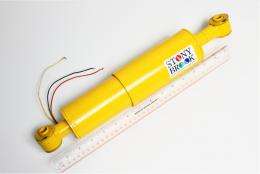July 14, 2011 weblog
Energy-harvesting shock absorber that increases fuel efficiency wins R&D 100 award

An energy-harvesting shock absorber that can be installed in a vehicle’s suspension system to absorb the energy from bumps in the road, convert the energy into electricity, and improve fuel efficiency by 1-8% has recently won the R&D 100 award. Nicknamed the “Oscar of Invention,” the annual award is given out by R&D Magazine to recognize the top 100 innovative technologies introduced during the previous year. Previous winners have included the ATM (1973), liquid crystal display (1980), Nicoderm anti-smoking patch (1992), lab on a chip (1996), and HDTV (1998).
The new shock absorbers were designed by Professor Lei Zuo and graduate students Xiudong Tang and Zachary Brindak at the State University of New York (SUNY) at Stony Brook, with funding from the New York State Energy Research and Development Authority (NYSERDA). The development joins regenerative braking and other techniques that address the vast amount of energy wasted by vehicles. Although transportation accounts for 70% of oil consumption in the US, only 10-16% of the fuel energy is used to drive the car - to overcome road resistance and air drag. The rest is lost due to braking, vibrational energy dissipation, exhaust heat, and other inefficiencies.
Zuo’s team developed and patented two different types of shock absorbers: linear and rotational. The new linear shock absorber consists of a small magnetic tube with high flux intensity that slides inside a larger, hollow coil tube. The rotational version employs a compact motion magnification mechanism.
Due to bumps and vibrations from normal driving, the sliding tubes or rotating generator can produce an electric voltage. When installed in a medium-sized passenger car traveling at 60 mph, the shock absorber can generate 100-400 watts of energy under normal driving conditions, and up to 1600 watts on particularly rough roads. Trucks, rail cars, and off-road vehicles get a return of 1-10 kilowatts, depending on road quality.
The harvested energy is then used to charge the battery and power the vehicle’s electronics, which is typically 250-350 watts with optional electronic systems turned off. This energy reduces the load on the vehicle’s alternator, which usually has a capacity about 500-600 watts. In this way, the harvested energy could increase fuel efficiency by 1-4% in conventional cars and by 8% in hybrid vehicles. As a side benefit, the shock absorber also creates a smoother ride due to the ability to adjust the suspension damping and implement self-powered vibration control.
The electricity-generating shock absorber can be retrofitted into today’s vehicles by replacing conventional shock absorbers - in which the vibration energy is wasted as heat - without modification of the vehicle suspension structure. The researchers estimate that the installation cost can be recouped in 3-4 years for typical passenger vehicles, and 1-2 years for trucks.
“If just 5% of the 256 million registered vehicles in this country adopt this technology, we will create a market of over six billion dollars,” said Zuo in a press release. “The total energy we can recover per year from the suspensions is more than the amount produced by the Niagara Falls Power Plant.”
Zuo added that the shock absorber is not yet commercially available, but the patent is ready for licensing. The researchers recently received a grant from the SUNY Technology Accelerator Fund to speed up commercialization.
More information:
Prof. Zuo's handout and R&D 100 awards
via: Asian American e-Zine
© 2010 PhysOrg.com












.jpg)





